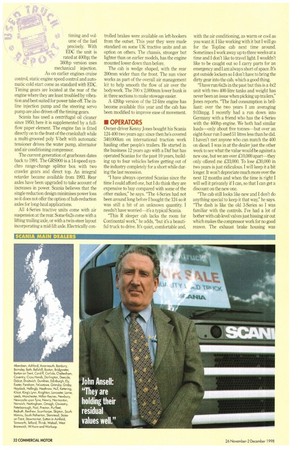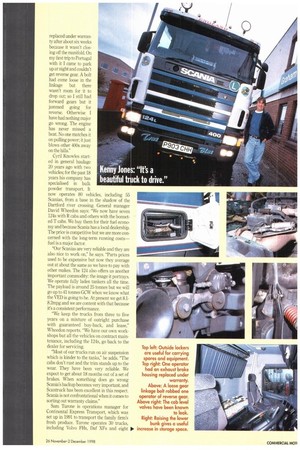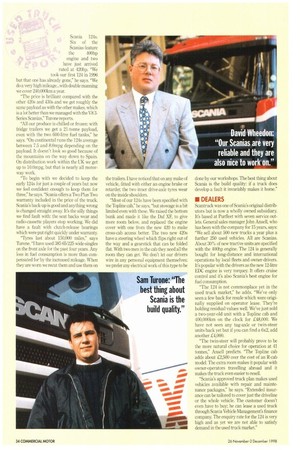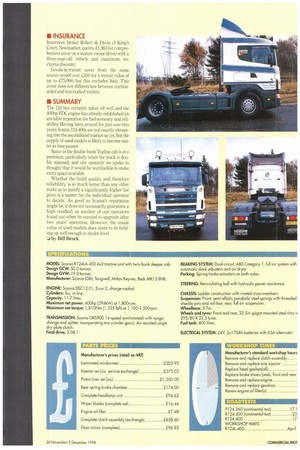COMPACT
Page 32

Page 33

Page 34

Page 35

Page 36

Page 37

If you've noticed an error in this article please click here to report it so we can fix it.
RIF RIF
MAIN PHOTOGRAPHY by TONY HOLK
• Scanias have always cost that bit extra and the more powerful models were, for a long time, largely the preserve of the owner-driver. This might still be the case, hut over the past few years the fleet-spec truck has moved a lot closer. Traffic congestion and driving hours rules have forced operators to look toward more power to solve logistics problems. Engine power ratings of around 380hp are now about the norm but, with higher weights in the offing next year it is unlikely to remain so for much longer.
• EVOLUTION
An all-new 11.7-litre engine is at the heart of the R124 which appeared in the UK in July 1996, later than on the Continent. The DSC12 straight-six charge-cooled turbo-diesel has individual heads and four valves per cylinder.
The unit is designed with a hot and a cold side, with the fuel system and inlet manifold located on the cold side. EDC monitors the Po
Since its UK launch in the Summer of 1996 the R124 has earned a reputation for economy and reliability. As used models come onto the market in greater numbers, they are bound to be in demand.
0 ur no-frills Scania R124-400, on loan from Eddie Stobart, was every bit as frugal as the Leyland Daf 85.400 and we were really impressed with the first day's running, which returned 9.4mpg uP to C Initial misgivings about the long-legged 3.08:1 final-drive ratio proved to be unfoun the truck also achieved cracking journey hnie..two good reasons why more operato) as Stobart were going for high-powered fleet tractors. The six-pot EDC 11.7-litre , Pulled strongly from about 1,200rpm, whether climbing hills or bumbling along in 64km/h, to confirm the benefit of the near-constant high level of torque available 14 1,100 and 1,500thrn. We didn't like the delay Passing through the range-change on & 14-speed GRS900 synchromesh transmission: wh needed to maintain momentum on the steepest hills c down-change left us with a big fat neutral Having a grated transmission is all very well but sometimes cli ment of individual components lags behind 8 proprietary units The ride was fairly soft,accentuated cab's four-point suspension and air-sprung seat Unde: conditions seat travel was excessive until we locked t) pension out. Seat design was
improving, however We had headrests that actually supported and integral seatbelts were the icing on the cake. We had to make do with drum brakes, but they were well up to the job. Spring park brakes on both axles held on a 20% gradient. We were not impressed with the grey interior finish but the enduring curved dashdesign, though the superfluous board was an example in ergonomic
al 6 switch area could have been better used to house the radio. Why door 1 Pockets were still only an option on a \ truck in this price bracket was a puzzle \
but we liked the three-section bunk. One \ big drawback was the kethweight. With a 450-litre tank it tipped the scales at 721 tonnes which put it in the MAN 18.403 class.
ta timing and vol ume of the fuel precisely. With EDC the unit is rated at 400hp; the 360hp version uses mechanical injection. As on earlier engines cruise control, static engine speed control and automatic cold start come as standard with EDC. Timing gears are located at the rear of the engine where they are least troubled by vibration and best suited for power take-off. The inline injection pump and the steering servo pump are also driven off the timing gears.
Scania has used a centrifugal oil cleaner since 1950; here it is supplemented by a fullflow paper element. The engine fan is fitted directly on to the front of the crankshaft while a multi-grooved poly V-belt with automatic tensioner drives the water pump, alternator and air conditioning compressor.
The current generation of gearboxes dates back to 1991. The GRS900 is a 14-speed syn. chro range-change splitter box with two crawler gears and direct top. An integral retarder became available from 1993. Rear axles have been upgraded to take account of increases in power. Scania believes that the single-reduction design minimises power loss so it does not offer the option of hub-reduction axles for long-haul applications.
All 4-Series tractive units come with air suspension at the rear. Some 6x2s come with a lifting trailing axle, or with a twin-steer layout incorporating a mid-lift axle. Electrically con trolled brakes were available on left-hookers from the outset. This year they were made standard on some UK tractive units and an option on others. The chassis, stronger but lighter than on earlier models, has the engine mounted lower down than before.
The cab is wedge shaped, with the rear 200mm wider than the front. The sun visor works as part of the overall air management kit to help smooth the flow of air over the bodywork. The 700 x 2,000mm lower bunk is in three sections to make stowage easier.
A 420hp version of the 12-litre engine has become available this year and the cab has been modified to improve ease of movement • OPERATORS Owner-driver Kenny Jones bought his Scania 124-400 two years ago: since then he covered 340,000km on international traction work hauling other people's trailers. He started in the business 12 years ago with a Daf but has operated Scanias for the past 10 years, building up to four vehicles before getting out of the industry completely for a short while during the last recession.
"I have always operated Scanias since the time I could afford one, but! do think they are expensive to buy compared with some of the other makes," he says. "The 4-Series had not been around long before I bought the 124 so it was still a bit of an unknown quantity. I needn't have worried—it's a typical Scania.
"This R sleeper cab lacks the room for Continental work," he adds, "but it's a beautiful truck to drive. It's quiet, comfortable and, with the air conditioning, as warm or cool as you want it. I like working with it but twill go for the Topline cab next time around. Sometimes I work away up to three weeks at a time and I don't like to travel light. I wouldn't like to be caught out so I carry parts for an emergency and lam always short of space. It's got outside lockers so I don't have to bring the dirty gear into the cab, which a good thing.
"I have run 6x2s in the past but this is a 4x2 unit with two 400-litre tanks and weight has never been an issue when picking up trailers," Jones reports. "The fuel consumption is brilliant: over the two years I am averaging 9.03mpg. I recently had a run down into Germany with a friend who has the 4-Series with the 460hp engine. We both had similar loads—only about five tonnes—but over an eight-hour run I used 51 litres less than he did. I haven't met anyone who can match the 400 on diesel. I was in at the dealer just the other week to see what the value would be against a new one, but we are over £10,000 apart—they only offered me £.33,000. To lose £30,000 in two years is just ridiculous, I will keep it a bit longer. It won't depreciate much more over the next 12 months and when the time is right I will sell it privately if I can, so that! can get a discount on the new one.
"The cab still looks like new and I don't do anything special to keep it that way," he says. "The dash is like the old 3-Series so I was familiar with the controls. I've had a lot of bother with cab level valves just hissing air out which makes the compressor work for no good reason. The exhaust brake housing was replaced under warranty after about six weeks because it wasn't closing off the manifold. On my first trip to Portugal with it I came to park up at night and couldn't get reverse gear. A bolt had come loose in the linkage but there wasn't room for it to drop out; so I still had forward gears but it jammed going for reverse. Otherwise I have had nothing major go wrong. The engine has never missed a beat. No one matches it on pulling power; it just blows other 400s away on the hills."
Cyril Knowles started in general haulage 20 years ago with two vehicles; for the past 18 years his company has specialised in bulk powder transport. It now operates 80 vehicles, including 55 Scanias, from a base in the shadow of the Dartford river crossing. General manager David Vv'heedon says: "We now have seven 124s with R cabs and others with the bonneted T cabs. We buy them for their fuel economy and because Scania has a local dealership. The price is competitive but we are more concerned with the long-term running costs— fuel is a major factor.
"Our Scanias are very reliable and they are also nice to work on," he says. "Parts prices used to be expensive but now they average out at about the same as we have to pay with other makes. The 124 also offers us another important commodity: the image it portrays. We operate fully laden tankers all the time. The payload is around 25 tonnes but we will go up to 41 tonnes GCW when we know what the VED is going to be. At present we get 8.18.2mpg and we are content with that because it's a consistent performance.
"We keep the trucks from three to five years on a mixture of outright purchase with guaranteed buy-back, and lease," Wheedon reports. "We have our own workshops but all the vehicles on contract maintenance, including the 124s, go back to the dealer for servicing.
"Most of our trucks run on air suspension which is kinder to the tanks," he adds. "The cabs don't rust and the trim stands up to the wear. They have been very reliable. We expect to get about 18 months out of a set of brakes. When something does go wrong Scania's backup becomes very important, and Scantruck has been excellent in this respect. Scania is not confrontational when it comes to sorting out warranty claims."
Sam Turone is operations manager for Continental Express Transport, which was set up in 1991 to transport the family firm's fresh produce. Turone operates 30 trucks, including Volvo FHs, Daf XFs and eight Scania 124s. Six of the Scanias feature the 400hp engine and two have just arrived rated at 420hp. "We took our first 124 in 1996 hut that one has already gone," he says. "We do a very high mileage...with double manning we cover 240,000km a year.
"The price is brilliant compared with the other 420s and 430s and we get roughly the same payload as with the other makes, which is a lot better than we managed with the V8 3Series Scanias," Turone reports.
"All our produce is chilled or frozen: with fridge trailers we get a 21-tonne payload, even with the two 600-litre fuel tanks," he says. "On continental runs the 124s average between 7.5 and 8.0mpg depending on the payload. It doesn't look so good because of the mountains on the way down to Spain. On distribution work within the UK we get up to 10.0mpg. but that is nearly all motorway work.
"To begin with we decided to keep the early 124s for just a couple of years but now we feel confident enough to keep them for three," he says. "Scania offers a Two Plus Two warranty included in the price of the truck. Scania's back-up is good and anything wrong is changed straight away. It's the silly things we find fault with: the seat backs wear and radio-cassette players stop working. We did have a fault with clutch-release bearings which were put right quickly under warranty.
"Tyres last about 150,000 miles," says Turone. "I have used 385 65/225 wide-singles on the front axle for the past four years. Any loss in fuel consumption is more than compensated for by the increased mileage. When they are worn we recut them and use them on the trailers. I have noticed that on any make of vehicle, fitted with either an engine brake or retarder, the two inner drive-axle tyres wear on the inside shoulders.
"Most of our 124s have been specified with the Topline cab," he says, "but stowage is a bit limited even with these. We raised the bottom bunk and made it like the Daf XF, to give more room below. and replaced the engine cover with one from the new 420 to make cross-cab access better. The two new 420s have a steering wheel which flips right out of the way and a gearstick that can be folded flat. With two men in the cab they need all the room they can get. We don't let our drivers wire in any personal equipment themselves; we prefer any electrical work of this type to he done by our workshops. The best thing about Scania is the build quality: if a truck does develop a fault it invariably makes it home."
• DEALERS
Scantruck was one of Scania's original distributors but is now a wholly owned subsidiary. It's based at Purfleet with seven service outlets. General sales manager John Ansel', who has been with the company for 15 years, says: "We sell about 500 new trucks a year plus a further 250 used vehicles. All are Scanias. About 30% of new tractive units are specified with the 400hp engine. The 124 is generally bought for long-distance and international operations by local fleets and owner-drivers. It's popular with the drivers as the new 12-litre EDC engine is very torquey. It offers cruise control and it's also Scania's best engine for fuel consumption.
"The 124 is not commonplace yet in the used truck market," he adds. "We've only seen a few back for resale which were originally supplied on operator lease. They're holding residual values well. We've just sold a two-year-old unit with a Topline cab and 400,000km on the clock for £48,000. We have not seen any tag-axle or twin-steer units back yet but if you can find a 6x2, add another £4,000.
"The twin-steer wilt probably prove to be the more natural choice for operation at 41 tonnes," Ansel' predicts. "The Topline cab adds about £2,500 over the cost of an R-cab model. The extra room makes it popular with owner-operators travelling abroad and it makes the truck even easier to resell.
"Scania's approved truck plan makes used vehicles available with repair and maintenance packages," he says. "Extended insurance can be tailored to cover just the ciriveline or the whole vehicle. The customer doesn't even have to buy; he can lease a used truck through Scania Vehicle Management's finance company. The enquiry rate for the 124 is very high and as yet we are not able to satisfy demand in the used truck market."
• INSURANCE
Insurance broker Robert & Davis of King's Court, Newmarket, quotes £1,963 for comprehensive cover on a mature owner-driver with a three-year-old vehicle and maximum noclaims discount.
Goods-in-transit cover from the same source would cost £450 for a transit value of up to £75,000, but this excludes Italy. This cover does not differentiate between curtainsided and box-bodied trailers.
• SUMMARY
The 124 has certainly taken off well and the 400hp EDC engine has already established an enviable reputation for fuel economy and reliability Having been around for just over two years Scania 124-400s are not exactly streaming into the secondhand market as yet, but the supply of used models is likely to become easier as time passes.
Space in the double-bunk Topline cab is at a premium, particularly when the truck is double manned, and one operator we spoke to thought that it would be worthwhile to make extra spac.. available.
Whether the build quality and therefore reliablility is so much better than any other make as to justify a significantly higher list price is a matter for the individual operator to decide. As good as Scania's reputation might be, it does not necessarily guarantee a high residual, as another of our operators found out when he wanted to upgrade after two years' operation. However, the resale value of used models does seem to be holding up well enough at dealer level.
IJ by Bill Brock SCANIA MAIN DEALERS Aberdeen, Ashford, Avonmouth, Banbury, Barnsley, Both, Bellshill, Boston, Bridgwater, Burton on Trent, Cardiff, Carlisle, Cheltenham, Coventry, Cross Hands, Darlington, Deeside, Didcot, Droilwich, Dumfries, Edinburgh, Ely, Exeter, Farehatn, Felixstowe, Grimsby, Groby, Haydock, Hellingly, Heathrow, Hull, Kettering, Kikot, King's Lynn, Knighton, Lancaster, Lame, Leeds, Manchester, Milton Keynes, Newbury, Newcastle upon Tyne, Newry, Nonnanton, Norwich, Nottingham, Omagh, Oswestry, Peterborough, Pool, Preston, PurReet, Redruth, Renfrew, Scunthorpe, Skiplon, South Mirnms, South Petherton, Stanstead, StokeornTrent, Stowmarket, Sutton in Ashfield, Tamworth, Telford, Thirsk, Walsall, West Bromwich, Witham and Worksop.
CIFICATIONS
MODEL: Scania R124LA 400 4x2 tractive unit with twin-bunk sleeper cab. Design GCW: 50.0 tonnes.
Design GVVV: 19.0 tonnes.
Manufacturer: Scania (GB), Tongwell, Milton Keynes, Beds MK15 8HB. BRAKING SYSTEM: Dual-circuit, ABS Category 1, Full air system with automatic slack adjusters and air dryer. Parking: Spring brake actuators on both axles.
ENGINE: Scania DSC12.01, Euro-2, charge-cooled.
Cylinders: Six, in-line.
Capacity: 11.7 litres.
Maximum net power: 400hp (294kW) at 1,800rom.
Maximum net torque: 1,810Nm (1,335 lbft) at 1,100-1,500rpm STEERING: Recirculating ball with hydraulic power assistance.
CHASSIS: Ladder construction with riveted cross-members. Suspension: Front, semi-elliptic parabolic steel springs with threaded shackle pins and roll-bar; rear, full air suspension.
Wheelbase: 3.7m.
Wheels and tyres: Front and rear, 22.5in spigot-mounted steel rims v 295/80 R 22.5 tyres Fuel tank: 400 litres TRANSMISSION: Scania GRS900 14-speed synchromesh with rangechange and splitter incorporating two crawler gears. Air-assisted single dry plate clutch.
Final drive: 3081. ELECTRICAL SYSTEM: 24V, 2x170Ah batteries with 65A alternator.
WORKSHOP TIMES
Manufacturer's standard workshop hours Remove and replace clutch assembly Remove and replace one injector Replace head gaskets(all) Replace brake shoes/pads, front and rear Remove and replace engine Remove and replace gearbox Renew engine oil filter's)
ROADTESTS
P124.360 (continental test) 17.1 RI 24.400 (continental test) 23 R124,400 17 WORKSHOP WAYS RI 24L.400 April
PARTS PRICES
Manufacturer's prices (retail ex-VAT)
Laminated windscreen £203.95 Injector set (six, service exchange) £373.02 Piston liner set (six) 21,050.00 Rear spring brake chamber £174.00 Complete headlamp unit £94.62 Wiper blades (complete set) £16.46 Engine oil filter £7.48 Complete clutch assembly (exchange) £658.60 Door mirror (complete) £96.85




















































































































